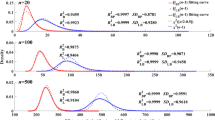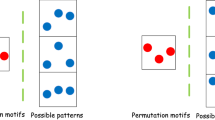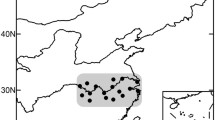Abstract
We develop a new cross-sample entropy, namely the multiscale cross-trend sample entropy (MCTSE), to investigate the synchronism of dynamical structure regarding two series with potential trends. It incorporates symbolic representation and polynomial fitting trend. Numerical tests illustrated that the newly proposed MCTSE can address the series with various trends well and detect asynchrony between two series more sensitively. The MCTSE is used to analyze the asynchrony between air quality index (AQI) series of Beijing, Changsha and Zhuhai and the series of six air quality impact factors (PM2.5, PM10, \(\hbox {SO}_2\), CO, \(\hbox {NO}_2\) and \(\hbox {O}_3\)). We find that the consistency between the AQI series and the two fine particulates series of PM2.5 and PM10 is obviously higher than other four factors series. Comparing the entropy values of these pollution factors between every two cities, we also found that the pollutants in Changsha and Zhuhai are similar in quality, but they are quite different from those in Beijing. These findings help to further explore the similarities and differences in dynamic structure of the AQI series and identify the main pollutant. This has certain reference value for the reduction and control of similar pollutants.







Similar content being viewed by others
References
Shannon, C.E.: A mathematical theory of communication. Bell Syst. Tech. J. 27(3), 379–423 (1948)
Renyi, A: On measures of entropy and information. In: Proceedings 4th Berkeley Symposium on Mathematical Statistics and Probability, vol. 5073, no. 1, pp. 547–561 (1961)
Pincus, S.M.: Approximate entropy as a measure of system complexity. PNAS 88, 2297–2301 (1991)
Pincus, S.M.: Approximate entropy (ApEn) as a complexity measure. Chaos 5, 110–117 (1995)
Pincus, S.M., Viscarello, R.R.: Approximate entropy: a regularity measure for fetal heartrate analysis. Obstet. Gynecol. 79, 249–255 (1992)
Schuckers, S.A.: Use of approximate entropy measurements to classify ventricular tachycardia and fibrillation. J. Electrocardiol. 31, 101–105 (1998)
Jaynes, E.T.: Information theory and statistical mechanics. Phys. Rev. 106, 620–630 (1957)
Jaynes, E.T.: On the rationale of maximum-entropy methods. Proc. IEEE 70(9), 939–952 (1982)
Schreiber, T.: Measuring information transfer. Phys. Rev. Lett. 85(2), 461 (2000)
Barnett, L., Barrett, A.B., Seth, A.K.: Granger causality and transfer entropy are equivalent for Gaussian variables. Phys. Rev. Lett. 103(23), 238701 (2009)
Bandt, C., Pompe, B.: Permutation entropy: a natural complexity measure for time series. Phys. Rev. Lett. 88, 174102 (2002)
Zunino, L., Soriano, M.C., Fischer, I., et al.: Permutation information theory approach to unveil delay dynamics from time series analysis. Phys. Rev. E 82, 046212 (2010)
Zunino, L., Olivares, F., Scholkmann, F., et al.: Permutation entropy based time series analysis: equalities in the input signal can lead to false conclusions. Phys. Lett. A 381(22), 1883–1892 (2017)
Fadlallah, B., Chen, B., Keil, A., et al.: Weighted-permutation entropy: a complexity measure for time series incorporating amplitude information. Phys. Rev. E 87, 022911 (2013)
Zunino, L., Olivares, F., Rosso, O.A.: Permutation min-entropy: an improved quantifier for unveiling subtle temporal correlations. EPL 109, 10005 (2015)
Fan, Q.J., Li, D.: Permutation min-entropy and statistical complexity analysis of electricity spot price. Fluct. Noise Lett. 14(04), 1550040 (2015)
Rosso, O.A., Blanco, S., Yordanova, J., et al.: Wavelet entropy: a new tool for analysis of short duration brain electrical signals. J. Neurosci. Methods 105(1), 65–75 (2001)
Rosso, O.A., Larrondo, H.A., Martin, M.T., et al.: Distinguishing noise from chaos. Phys. Rev. Lett. 99, 154102 (2007)
Zunino, L., Zanin, M., Tabak, B.M., et al.: Complexity-entropy causality plane: a useful approach to quantify the stock market inefficiency. Physica A 389, 1891–1901 (2010)
Richman, J.S., Moorman, J.R.: Physiological time-series analysis using approximate entropy and sample entropy. Am. J. Physiol. Heart Circ. Physiol. 278, 2039–2049 (2000)
Liu, L.Z., Qian, X.Y., Lu, H.Y.: Cross-sample entropy of foreign exchange time series. Physica A 389, 4785–4792 (2010)
Costa, M., Goldberger, M.A.L., Peng, C.K.: Multiscale entropy analysis of complex physiologic time series. Phys. Rev. Lett. 89(6), 068102 (2002)
Zunino, L., Soriano, M.C., Rosso, O.A.: Distinguishing chaotic and stochastic dynamics from time series by using a multiscale symbolic approach. Phys. Rev. E 86(4), 046210 (2012)
Xia, J.N., Shang, P.J.: Multiscale entropy analysis of financial time series. Fluct. Noise Lett. 11, 1250033 (2012)
Yin, Y., Shang, P.J.: Comparison of multiscale methods in the stock markets for detrended cross-correlation analysis and cross-sample entropy. Fluct. Noise Lett. 13, 1450023 (2014)
Wu, S.D., Wu, C.W., Lin, S.G., et al.: Time series analysis using composite multiscale entropy. Entropy 15(3), 1069–1084 (2013)
Yin, Y., Shang, P.J.: Modified multiscale cross-sample entropy for complex time series. Appl. Math. Comput. 289, 98–110 (2016)
Yin, Y., Shang, P.J.: Modified cross sample entropy and surrogate data analysis method for financial time series. Physica A 433, 17–25 (2015)
Kantelhardt, J.W., Zschiegner, S.A., Koscielny-Bunde, E., et al.: Multifractal detrended fluctuation analysis of non-stationary time series. Physica A 316(1/2/3/4), 87–114 (2002)
Wang, F., Liao, G.P., Li, J.H., et al.: Multifractal detrended fluctuation analysis for clustering structures of electricity price periods. Physica A 392(22), 5723–5734 (2013)
Wang, F., Li, Z.S., Li, J.W.: Local multifractal detrended fluctuation analysis for non-stationary image’s texture Segmentation. Appl. Surf. Sci. 233, 116–25 (2014)
Wang, F., Liao, D.W., Li, J.W., et al.: Two-dimensional multifractal detrended fluctuation analysis for plant identification. Plant Methods 11, 12 (2015)
Wang, F., Fan, Q.J., Stanley, H.E.: Multiscale multifractal detrended-fluctuation analysis of two-dimensional surfaces. Phys. Rev. E 93, 042213 (2016)
Gieraltowski, J., Zebrowski, J.J., Baranowski, R.: Multiscale multifractal analysis of heart rate variability recordings with a large number of occurrences of arrhythmia. Phys. Rev. E 85, 021915 (2012)
Gieraltowski, J., Hoyer, D., Teschke, F., et al.: Development of multiscale complexity and multifractality of fetal heart rate variability. Auton. Neurosci. 178, 29–36 (2013)
Shi, W.B., Shang, P.J., Lin, A.J.: Multiscale multifractal detrended cross-correlation analysis of financial time series. Physica A 403, 35–44 (2014)
Wang, J., Shang, P.J., Cui, X.R.: Multiscale multifractal analysis of traffic signals to uncover richer structures. Phys. Rev. E 89, 032916 (2014)
Shi, W.B., Shang, P.J.: Cross-sample entropy statistic as a measure of synchronism and cross-correlation of stock markets. Nonlinear Dyn. 71, 539–554 (2013)
Xiong, H., Shang, P.J.: Weighted multifractal cross-correlation analysis based on Shannon entropy. Commun. Nonlinear Sci. Numer. Simul. 30, 268–283 (2016)
Wu, Y., Shang, P.J., Li, Y.L.: Multiscale sample entropy and cross-sample entropy based on symbolic representation and similarity of stock mark. Commun. Nonlinear Sci. Numer. Simul. 56, 49–61 (2018)
Patil, A., Santhanam, M.S.: Random matrix approach to categorical data analysis. Phys. Rev. E 92, 032130 (2015)
Fontana, M., Loper, K.A.: Kronecker function rings: a general approach. In: Anderson, D.D., Papick, I.J. (eds.) Ideal Theoretic Methods in Commutative Algebra. Lecture Notes in Pure and Applied Mathematics, vol. 220, pp. 189–205. Marcel Decker, New York (2001)
Peitgen, H.O., Jürgens, H., Saupe, D.: Chaos and Fractals: New Frontiers of Science. Springer, Berlin (2004)
Xu, W., Liu, C., Shi, K., et al.: Multifractal detrended cross-correlation analysis on NO, NO\(_2\) and O\(_3\) concentrations at traffic sites. Physica A 502, 605–612 (2018)
Wang, F., Wang, L., Chen, Y.M.: Detecting PM2.5’s correlations between neighboring cities using a time-lagged cross-correlation coefficient. Sci. Rep. 7, 10109 (2017)
Wang, F., Wang, L., Chen, Y.M.: A DFA-based bivariate regression model for estimating the dependence of PM2.5 among neighbouring cities. Sci. Rep. 8, 7475 (2018)
Han, L.J., Zhou, W.Q., Li, W.F.: Increasing impact of urban fine particles (pm 2.5) on areas surrounding Chinese cities. Sci. Rep. 5, 12467 (2015)
Han, L.J., Zhou, W.Q., Li, W.F.: City as a major source area of fine particulate (pm 2.5) in china. Environ. Pollut. 206, 183–187 (2015)
Zhang, J., Small, M.: Complex network from pseudoperiodic time series: topology versus dynamics. Phys. Rev. Lett. 96(23), 238701 (2006)
Xu, X., Zhang, J., Small, M.: Superfamily phenomena and motifs of networks induced from time series. Proc. Natl. Acad. Sci. 105(50), 19601–19605 (2008)
Lacasa, L., Luque, B., Ballesteros, F., et al.: From time series to complex networks: the visibility graph. Proc. Natl. Acad. Sci. 105(13), 4972–4975 (2008)
Luque, B., Lacasa, L., Ballesteros, F., et al.: Horizontal visibility graphs: exact results for random time series. Phys. Rev. E 80(4), 046103 (2009)
Sun, X., Small, M., Zhao, Y., et al.: Characterizing system dynamics with a weighted and directed network constructed from time series data. Chaos 24(2), 024402 (2014)
Charakopoulos, A.K., Karakasidis, T.E., Papanicolaou, P.N., et al.: The application of complex network time series analysis in turbulent heated jets. Chaos 24(2), 024408 (2014)
Gao, Z.K., Small, M., Kurths, J.: Complex network analysis of time series. EPL 116(5), 50001 (2017)
Acknowledgements
The author wishes to thank the anonymous reviewers and the handling editor as well as associate editor Dr. J. A. Tenreiro Machado for their constructive comments and suggestions, which led to a great improvement to the presentation of this work. This work was partially supported by Philosophy and Social Science Foundation of Hunan Province (CN) (Grant No. 18YBA226).
Author information
Authors and Affiliations
Corresponding author
Ethics declarations
Conflict of interest
The authors declare that they have no conflict of interests.
Additional information
Publisher's Note
Springer Nature remains neutral with regard to jurisdictional claims in published maps and institutional affiliations.
Rights and permissions
About this article
Cite this article
Wang, F., Zhao, W. & Jiang, S. Detecting asynchrony of two series using multiscale cross-trend sample entropy. Nonlinear Dyn 99, 1451–1465 (2020). https://doi.org/10.1007/s11071-019-05366-y
Received:
Accepted:
Published:
Issue Date:
DOI: https://doi.org/10.1007/s11071-019-05366-y




